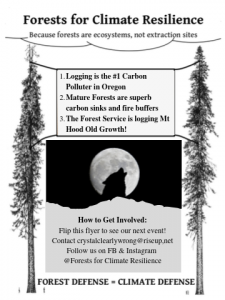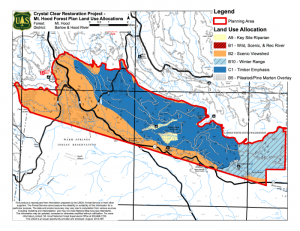About
 Forests for Climate Resilience
Forests for Climate Resilience
We are a resurgent grassroots group working to alert the people of the central Cascades to the crucial and urgent opportunity to address climate change by stopping logging in mature and old growth forests, right now. We work with a range of grassroots groups, including environmental nonprofits, and are committed to centering indigenous peoples and struggles. In addition to education and movement building, we bring the option of principled, strategic direct action and civil disobedience to the table. Our current focus is on the largest timber sale on Mt Hood in memory, including 3000 acres of mature and old growth forest for the first time in a generation: called Crystal Clear.
Crystal Clear Timber Sale


In September 2018, forest and wildlife protection organizations brought a lawsuit in federal district court to halt the Crystal Clear timber sale for violations of the National Environmental Policy Act (NEPA), National Forest Management Act (NFMA) and the Travel Management Rule. On May 7, 2019, District Judge Michael Mosman ruled against the plaintiffs on all claims, but did not file an opinion.
Project Details: Along the eastern shoulder of Mt. Hood National Forest (MHNF) lies a complex forest: diverse in species composition, elevation, forest type, past management, and fire history. Overlaying this diverse forest is a mantle of protection − designated critical habitat for the iconic northern spotted owl, a federally threatened species. This forest diversity expresses itself in many ways. In the higher elevation, moist mixed conifer forests where fire is an infrequent visitor and commercial logging has not altered the landscape, multiple tree species grow together providing high-functioning habitat for northern spotted owl and other threatened and sensitive animals and plants. Interspersed in these older forests are areas logged decades ago, where a sparse overstory of elder trees shelters a new understory of young conifers. Head east, down the mountain, and the forest changes. Here, fire was a more common visitor, regularly clearing the forest underbrush to nourish pines and other fire-adapted conifers.
Across this ecologically important and diverse forest, MHNF planned its largest timber sale in over a decade, including plans to log almost 3,000 acres of mature and old growth forest. Under direction from the Forest Service Regional Office, MHNF used Timber Sale Pipeline Restoration Funds to plan a sale the Regional Office expected to produce 100,000 CCF of timber (approximately double the timber volume produced annually on the entire Forest). Encompassing 11,742 acres, the “Crystal Clear Restoration Project” is the result.
Crystal Clear is proposed in the White River watershed in Mt. Hood National Forest just north of the Confederated Tribes of Warm Springs boundary. Indigenous peoples still use this area for harvest and recreation. This area is home to spectacular winter and summer recreation opportunities accessible along Highway 26, and also plays the significant role of sequestering and storing carbon, which is critical to mitigating the projected effects of climate change.
The White River Watershed contains approximately 555 miles of roads, making it high priority for reducing road density within habitat for sensitive species impacted by vehicular traffic and road-related erosion. The Crystal Clear Timber Sale will build or re-open up to 35.8 miles of “temporary” road, and only decommission 0.7 miles.The Crystal Clear project area also includes the McCubbins Gulch OHV riding area, one of three designated Off Highway Vehicle riding areas in Mt. Hood National Forest.
In 2014, wolf tracks were confirmed by wildlife agencies in the White River area of Mt. Hood National Forest, and within the Crystal Clear project area. The two-year old male wolf that made its way to our forests this year is collared OR-25 from the Imnaha Pack in eastern Oregon. In the winter of 2017, the Oregon Department of Fish and Wildlife trail cameras documented a pair of wolves in the area and in August of 2018, the pair was confirmed to have at least two pups.
Instead of pursuing activities which degrade native forest, we believe that the Forest Service should prioritize decommissioning roads which are currently damaging to the ecosystem, restoring wildlife such as beavers which can bring further recovery of the watershed, and promoting the natural and invigorating role of fire on the eastside of Mt. Hood.